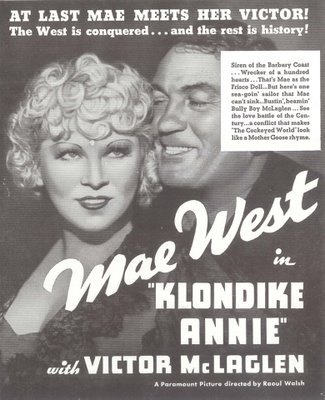
 Mae West --- Part Two
Mae West --- Part TwoNearing forty before stepping in front of cameras, Mae West was a frequently overweight and scarcely alluring figure who, nevertheless, brilliantly portrayed a sex symbol. It was indomitable that enabled West to present herself as America’s foremost man-eater. Love scenes were about build-up, never consummation. When time came for the kiss, her leading man would spin Mae away from the camera so we’d seldom see lips meet. Male co-stars could thus depend on at least one close-up of the back of their heads. Sexual excess took place off screen, even in the precodes. For movies all about Topic A, hers are the most sexless of all. Men lavished Mae with diamonds and furs, but there was seldom even suggestive dissolve to indicate what their remuneration might be. Any actress at Warners scored more illicit fade-outs (if not on-screen couplings) than West, but none poked such fun at censor stress over sex. She would be made to realize, however, that censors do not care to be ridiculed.


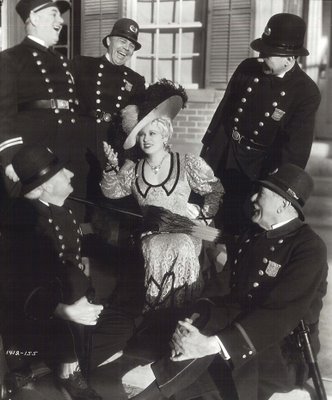
Mae didn’t just wink at sex in interviews --- she gorged herself on it. A policy of provoking media critics had worked to her advantage in New York, but these were far more provincial movie audiences she was tweaking, and their patience wore thin with ribald tales of West’s legion of lovers. Viewers were laughing with her, but she was laughing at them. It was time to bring Mae down a few pegs. Forceful demonstrations by the Catholic Church got the message across --- either clean up or close down. West had three pictures in release when the newly enforced Code paid a call. Paramount exchanges were obliged to pull so-far Wests for shelf duty, while her newest, It Ain’t No Sin, went back to drawing boards. In view of scrutiny applied here, there would surely be no sinning by the time It Ain't No Sin reached theatres. The title was first to be jettisoned, many offended merely by that, so down came billboards plus a nationwide flock of parrots that had been trained to recite, It Ain’t No Sin! for ballyhoo purpose. Leo McCarey directed, salvaged a good picture out of wreckage, then vowed in accordance with colleagues before and after not to work with Mae West again. She confounded PCA edict by shooting censorable footage, then meekly submitting to its removal, knowing stuff she really wanted would be overlooked during furious exchange of memos. That worked for a while, but you can only fool some of the people part of the time, and these weren’t fools she was up against. Indeed, they would have her movie career on a plate within a few short years.

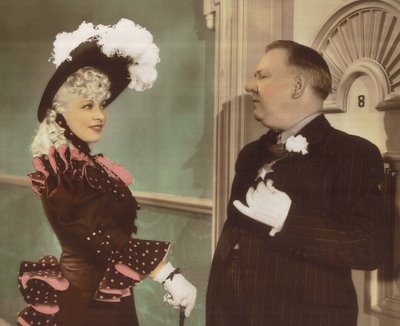
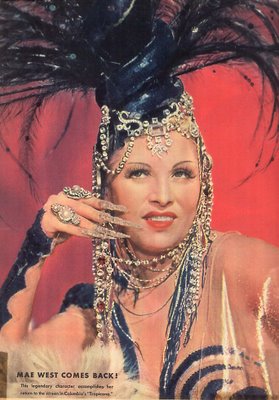
Throughout nearly fifty years living in Hollywood, Mae’s phone number was listed in the book. Not that she was accessible. Fans weren't wanted up close. Once she was robbed at gunpoint. The lowlife element figured West for a walking jewelry counter. Well, she was Diamond Lil after all. Violent crime sometimes walked hand-in-hand with celebrity. Mae’s chauffeur/lover and bodyguard both carried guns, while their employer cradled a pet monkey within the linings of her fur. Similar eccentricities were visited upon business associates as well. Mae knew how to keep opponents off balance with extravagant demands and seemingly irrational behavior. By the time they got back their equilibrium, the deal was done, and she had won. It all worked like a charm until the grosses started drying up. Mae West was suddenly like every other actress who scorched 'em in pre-codes, but was now de-clawed and deadly dull. Klondike Annie varied the formula by having her impersonate a missionary, and this she played without irony or condescension. It might have been the best and bravest screen work she'd done, but it was too late. The finishing touch came unexpectedly when Mae guested on The Chase and Sanborn Hour with Edgar Bergen and Charlie McCarthy , the broadcast night that would live in radio infamy was December 27, 1937. Her own proposed script had been nixed by network standards, and she team-played through rehearsals, but when the live broadcast light went on, Mae threw caution to winds and did double-entendres per initial intent, much of a listener public running for telephones to tell friends of the dirty program travelling airwaves. NBC was apoplectic, and vowed never to allow Mae West on the air again. Resulting bad publicity sent chills through Paramount soundstages. Motion Picture Herald listed her among stars now labeled "Boxoffice Poison." Efforts to surround West with aged low comedians in Every Day’s A Holiday couldn’t rehabilitate her. The combination of circumstances made getting rid of West a sound fiscal decision for the studio.

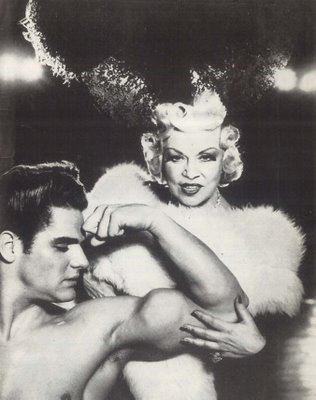
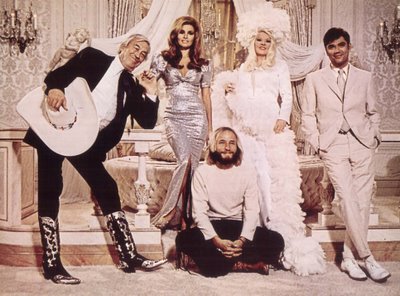
She found refuge back on the stage. A decade long obsession had been to film her play, Catherine Was Great. Now she would weigh herself down in period costumes (one topped the scales at 75 pounds) and embark upon a road tour a goal of which was to bring the thrill of Mae West In Person to smaller towns she had not encountered since vaudeville. Hollywood still gave her the freeze --- a teaming with Bill Fields did him more good than her, and The Heat’s On for Columbia was a plain disaster. Canteen work during the war was out, Mae no good for small talk with soldiers and loathing close contact these spots entailed. She was insulted when Billy Wilder offered Sunset Boulevard, but imagine how scary Mae would have been as Norma Desmond --- poor Joe Gillis could never have survived a first introduction to her. Muscle boys in her Vegas cabaret act found Mae a hard taskmaster as well. One of them was sufficiently traumatized by her insatiable demands (both on and off stage) as to quit the show and join a monastery. Platform shoes Mae wore made Karloff’s Frankenstein boots seem like carpet slippers by comparison, straps cutting into feet left her in agony. Mae's own hair and eyelashes were long since ruined with chemicals and enhancements over the years. Now she was a mannequin dressed as though for a window display. Sister Beverly was an off and again servant who drank. Resentments festering for years boiled up from time to time. When Mae decided to tackle her memoirs, she found that rats had eaten old documents and records. The play was still the thing. Mae West now spoke of herself in the third person --- there was little of the first person left. Interviewers began commenting on the eerie and gothic nature of encounters with her, and this would become the rallying point for lazy scribes. Fact is, Mae West had an unerring sense of self and complete grasp of who she was and why she mattered to the popular culture, all this summed up beautifully in her memoir, Goodness Had Nothing To Do With It, one of the great show biz look-backs. She was the only cast member in Myra Breckinridge not utterly degraded for participating, Mae above the fray with tried and true material she wrote herself. You could argue the comeback was ill-advised, but also that it seemed like a good idea at the time. How could West have realized how coarsened the film industry had become? She had, after all, been away from it since the 40's. A last starring vehicle at age 84 (Sextette) was clearly not in her best interests, but you had to admire West seeing it through. Performing was the life she knew, age a thing to be daily conquered and overcome. That last hospital stay found her hauling a 16mm projector into the room so she could screen movies --- Mae West movies, of course. She died in 1980 at the age of 87.
Photo Captions
Ad Art for Klondike Annie
Klondike Annie
Paramount Publicity Portrait
Ad Art for Every Day's A Holiday
Every Day's A Holiday
Publicity Still with Charlie McCarthy for The Chase and Sanborn Hour
With W.C. Fields in My Little Chickadee
Color Portrait for Tropicana --- released as The Heat's On
Newspaper Ad for Mae's Stage Show
With musclemen for her Las Vegas Cabaret Revue
With the cast and director of Myra Breckinridge
5 Comments:
Sextette was almost painful to sit through, and I couldn't help but feel embarrassed for Mae. Films like that are the reason I have such respect for the Cary Grants and Doris Days of the entertainment industry, who opt to quit while they're ahead rather than end up playing sad parodys of themselves.
Almost painful? I defy anyone to sit through the entire film! It's my vote as the worst film ever made. Mae was the real life Norma Desmond who actually got to make her Salome..only it was called Sexette! Great article on Mae though, I enjoyed reading it.
Actually, Joe Gillis DOESN'T make it through the first reel... but we know what you meant. ; )
I enjoy your website but I think you missed the boat in analyzing - or understanding - Mae West. Beulah, peel me a raspberry.
Greg, your comment was very ugly. Russell's too. I respect Mae West for wanting to work. She had the energy and drive to do it. 1978 was not the greatest year for film anyway.
Post a Comment
<< Home